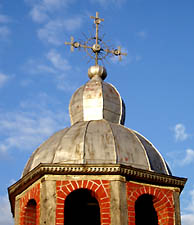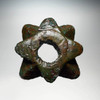Product Description
This small mace head was once mounted on a long shaft handle and wielded by a mounted cavalry soldier who would have fought during the time of the Late Eastern Roman Byzantine Empire. By this period in time, the power of the military rested with the Cavalry as a majority of the foot soldiers were both inexperienced and poorly armed. Cavalry weapons of this period are very uncommon and rare in the market.
This is a RARE and superb example of a PYRAMIDAL KNOBBED MACE. It is made from bronze and in ancient times, its bright gold original appearance was likely an object to display high military rank amongst soldiers as bronze weapons in this period were very few in number compared to iron. This specimen is a complete and excellent example showing no damage. It came from an old European collection and retains a spectacular heavy rich green mineralized patina on all surfaces. Solid and well-preserved.
Cavalry shaft-mounted weapons like battle hammers, maces and axes were often very small and mounted on long handles. The speed and momentum in swinging such a weapon was made effective by the long shaft length and whipping action of the weapon rather than by the brute weight of the weapon itself as those used by ground infantry. Heavy hand weapons were not as effective when mounted on a horse as they were too slow and cumbersome to use. Additionally, the speed of the horse made up for the impact force as an enemy was struck while moving on horseback.
Unlike most metal artifacts sold on the market that are untreated and uncleaned, our specimens our properly cleaned, inspected and conserved in our museum conservation lab prior to being offered for sale to our clients. Every piece we offer is cleaned, stabilized and treated in our facility. If it were not treated properly, it likely would deteriorate into further corrosion and possibly disintegrate into pieces. All our artifacts are guaranteed for life to not further corrode in normal storage environments. The vast majority of sellers of metal artifacts do NOT PROPERLY clean and treat their specimens and many do nothing at all. If those artifacts are NOT treated and stabilized correctly, THEY WILL CONTINUE TO DISINTEGRATE AND CORRODE AND COULD EVENTUALLY FALL APART INTO PIECES.
HISTORY
 Perhaps no other epoch in history is so unique, extensive and yet, as much forgotten as that of the Byzantine Roman Empire. From the founding of its new capitol in Constantinople, 330 AD to its final fall to the Ottoman invaders in 1453, over eleven hundred years of history has virtually been lost in most minds of the Western world. Ironically, it is this exact history that has extensively shaped the Western cultures today, especially those of the Christian faith.
Perhaps no other epoch in history is so unique, extensive and yet, as much forgotten as that of the Byzantine Roman Empire. From the founding of its new capitol in Constantinople, 330 AD to its final fall to the Ottoman invaders in 1453, over eleven hundred years of history has virtually been lost in most minds of the Western world. Ironically, it is this exact history that has extensively shaped the Western cultures today, especially those of the Christian faith.
No event in Western history was probably more pivotal than that of the Christian conversion of the Roman emperor Constantine I. Up to that time, Christians were heavily persecuted by many of the previous emperors and the religion was outlawed. That would all change in 324 AD with a miraculous military victory and subsequent conversion to Christianity by Constantine I at the Milvian Bridge. From this point on, Christianity became the official religion of the Empire. A new capitol was established in Constantinople (present day Istanbul, Turkey) and power was fully transferred from Rome to Constantinople in 476 AD. It was not the end of the Roman Empire but a continuation and fascinating transformation of Roman rule that would last for another one thousand years!
In the Byzantine Period, the Roman Empire and Christianity were completely interwoven. It was the quintessential example of the UNION of church and state. What was once the ancient world's greatest enemy of the faith, overnight became its most devoted advocate. The classic architecture, style of dress, and overall appearance of all that was "Old Rome" took on a new and intricate style that the world has never seen before or since. This was not only attributed to the influence of the capitol's new geographic location, but also to the foremost prominence of Christianity in the Roman world.
A well-known remnant of the Byzantine Period is the stunning and unique art of the religious Icons. This abstract spiritual style can be immediately recognized and is evident in not only paintings and mosaics but also the era's architecture and coins. What was once thought of as crude numismatic issues are now appreciated as highly stylized symbols of the Romans' devout faith.
After the establishment of Constantinople as the new capitol and navel of the Roman world, the Empire continued for almost a millennium eventually bridging ancient and medieval history but not without its share of enemies. Numerous challenges of foreign armies took its toll on defenses and finally, on May 29, 1453 AD, the Muslim Ottomans overran the crumbling city walls and the sun set forever on the greatest empire that the ancient world had ever known.
 US DOLLAR
US DOLLAR
 EURO
EURO
 AUSTRALIAN DOLLAR
AUSTRALIAN DOLLAR
 CANADIAN DOLLAR
CANADIAN DOLLAR
 POUND STERLING
POUND STERLING














